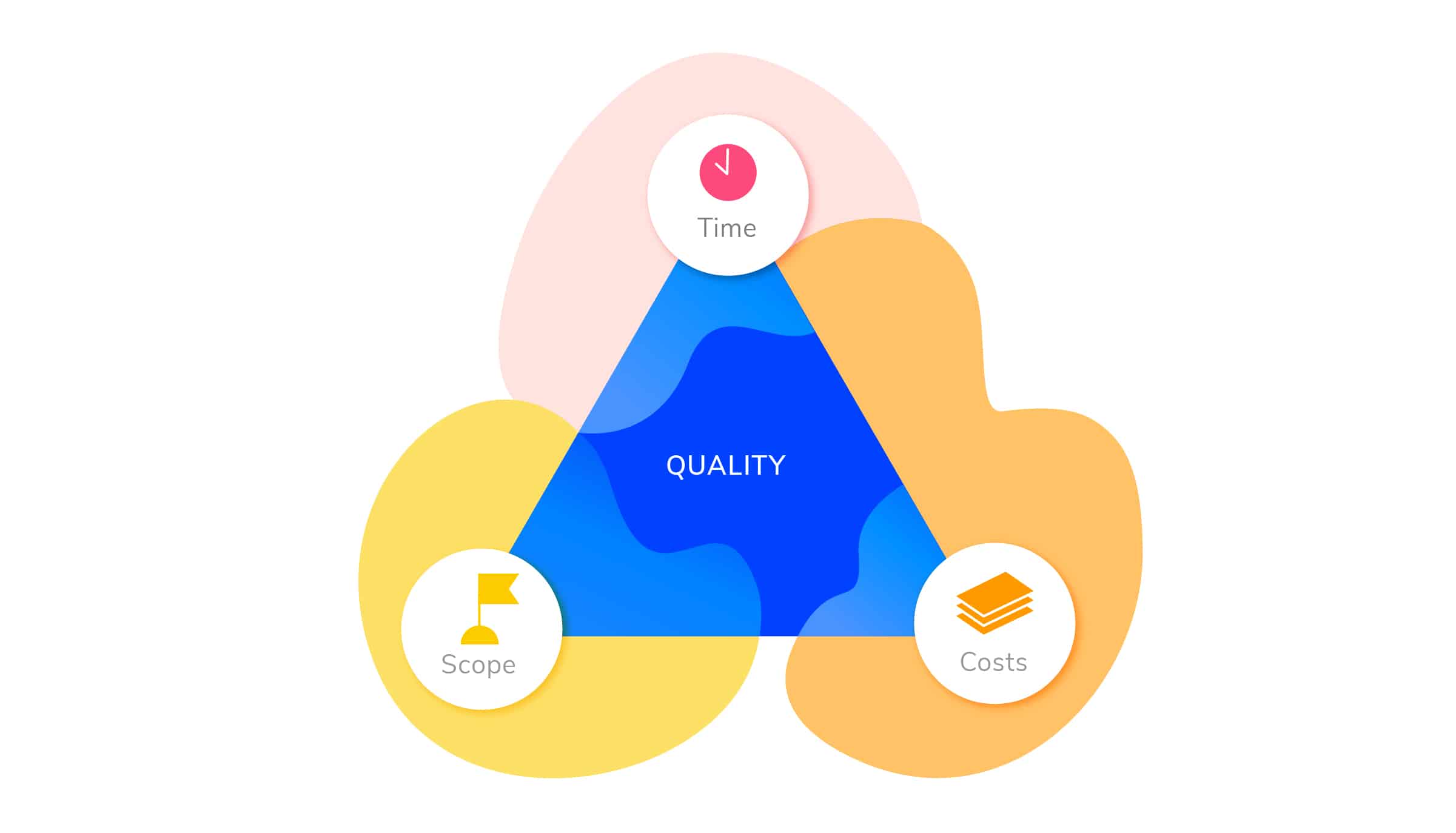The Iron Triangle. The Triple Constraint Theory. They sound like the names of DC villains or underground political movements, but there’s no need to call Batman. When you’re managing a project, you’re glad that they exist.
The triple constraints of project management define three interconnected elements that keep everything in perspective and on track. They are:
- Scope
- Time
- Costs
The concept usually appears as a triangle, with quality as the focal point and the three constraints forming the vertices. Together they add up to a fixed set of expectations, a verified schedule, and an established budget. When planned carefully and balanced well as the project progresses, they can lead to a successful outcome.

Scope
The scope of a project determines and defines its goals, deliverables, tasks, and deadlines. In other words, scope specifies:
- Required achievements
- What work is necessary to bring about the desired result
When you’re managing scope, it’s critical to create a sense of order by prioritizing tasks, assigning resources efficiently, and carefully managing any changes requested by stakeholders. Many projects, however, fail with this vital constraint because:
- It has not been properly defined in the planning stages OR
- The project manager agrees to changes that don’t support project goals and deliverables
The Triple Connection: If you increase the scope of your project, the budget or schedule will have to expand too. If, for example, your client widens the scope of a software project after learning about a similar, competing product now on the market, you may have to push up the delivery date and hire more staff to minimize schedule disruption, which in turn increases project cost.
![]()
Time
Also known as the schedule, a project’s timeframe includes:
- The start and finish dates for activities, tasks, and milestones
- The logical sequence of all activities
- The deadline for all deliverables
Effective scheduling is integral to a positive outcome, which is why project management solutions like Toggl Plan use Gantt charts to visualize a timeline. Each task is included on the map, along with its duration and dependencies, so that everyone has a clear idea of how the project is progressing.
The Triple Connection: If you reduce the project’s timeline, the cost will have to increase or the scope will have to decrease in order to restore balance. For example, if your customer asks you to bring a product launch date forward to coincide with a trade show or conference, you may have to add more people to meet the new deadline, which costs more in additional salaries. Alternatively, you could accommodate the schedule change by removing some product features, which decreases the scope of the project.
Cost
Practically all projects have a confirmed budget that provides the basis for cost control. For example, the client is willing to spend $60,000 to have you develop and deliver a new software platform for their business. When you measure actual costs against this approved budget, you can confirm whether the project is going according to plan or if changes are necessary.
Cost is generally estimated using variables like the following:
- Historical costing data collected from similar projects
- Assembling the going rate for all necessary goods and labor
- Any vendor bids submitted for the project
- Risk estimates
Any aspects of your project that have a monetary component become part of your cost structure and therefore your budget.
The Triple Connection: If you reduce the project budget cost, the scope will have to be trimmed down or the timeline extended. This situation can occur if your client cuts the budget for any reason, such as poor financial performance at their parent company. Less money means that the scope needs to be reduced to accommodate the new budget and the deadline pushed back so that you can locate less expensive resources.
![]()
What About Quality?
Although the theory is called the triple constraints of project management, ‘quality’ is often included in the equation as a fourth wheel. It is similar to scope except that it focuses on characteristics of the deliverable(s). Quality also works in the same manner as the three constraints. For example, if your project is running late or coming too close to budget limits, you may still be able to deliver, but some characteristics may have been eliminated to save time or the testing period could have to be cut short. In both cases, quality is affected.
You can also deliver a project on time and within both the scope and the budget, but the quality may not be what the customer was hoping for. Because this is a subjective factor, the only way to measure it is by holding regular conversations with stakeholders and clients.
Why Do They Matter?
The triple constraint involves the balancing of scope, time, and cost until the project reaches a successful conclusion. Any changes to key attributes, whether they are requested by the client or come as a total surprise, will impact the others, requiring you to alter one or both of the other components to support the new additions or subtractions. Never assume that you can change one and leave the others as is: there is ALWAYS an effect on the other two that will call for some adjustments.
Once you understand these interdependencies, you will know what accommodations must be made when the client cuts the budget, moves the deadline one week ahead, or dumps their entire wishlist of new product features on you at the last minute. You’ll also be able to act more quickly, making any imbalances are as brief as possible.
Many project managers have compared the triple constraints of project management to a balancing act. Like juggling, it looks pretty straightforward- until you try it yourself. You also need to improve your mastery of the art via regular practice. Over time, the process can become intuitive based on experience, but until you reach that point, understanding this theory of checks and balances will help you make informed decisions during your project.
Rose Keefe is an author and technical writer who has over ten years’ experience in supporting project managers in the manufacturing and construction sectors. One of her primary responsibilities was developing product manuals that supported efficient use of industrial equipment. She continues to write on the subject of time management and commercial productivity for trade websites and publications.

![How To Make A Project Schedule? [A Step-by-Step Guide]](https://toggl.com/blog/wp-content/uploads/2024/01/project-schedule-673x404.jpg)